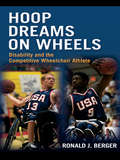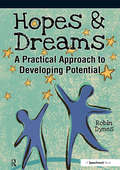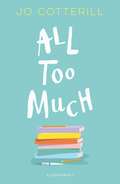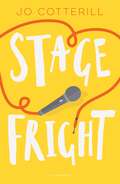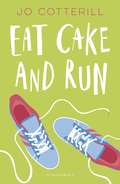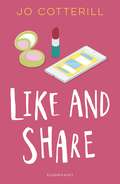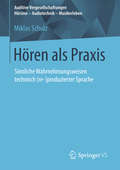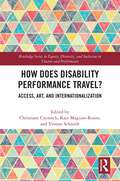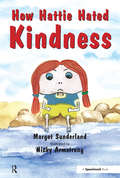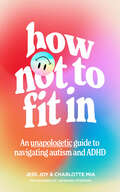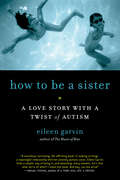- Table View
- List View
Homespun Remedies: Strategies in the Home and Community for Children with Autism Spectrum and Other Disorders (PDF)
by Dion Betts Nancy J Patrick`Written by professionals, who also have personal experience of living with a child with special needs, this book offers solutions to specific difficulties commonly experienced by children with Autistic Spectrum Disorder (ASD). From hair cuts to homework, the solutions offered revolve around core principles of providing predictability and structure whilst utilizing visual prompts where possible.' - youthinmind.co.uk `Homespun remedies is a useful source of reference for anyone living or working with a child with ASD. It is presented in a practical and easy reading style, on a topic that can be complex and very difficult to understand at times. Some of the common daily problems facing children with ASDs are touched on in a clear and simple manner and parents may find comfort and reassurance in reading other parents' experiences of these.' -The Frontline of Learning Disability, Autumn 2006 `The book has an easy-to-read style, and can either be read straight through or dipped into for advice. It gives a good impression of the variety of difficulties families with ASD have to cope with, and how to overcome or cope with them.' - Education Otherwise `Betts and Patrick have successfully managed to describe many handy hints used by parents of children with Autistic Spectrum Disorder that have proved valuable in understanding better the implications of disorders of communication, social relatedness, and self regulation found in children with Autistic Spectrum Disorder (ASD). They give many examples of simple interventions that parents can use to help their child with ASD to cope better with the daily demands made on the child, to reduce stress and to make more sense of the world… Homespun Remedies is easy and enjoyable to read and it will help parents/carers and those unfamiliar with ASD to gain an introductory picture of what it means to live with ASD and how to remedy some of the difficulties associated with it.' - Support for Learning `This useful book, in jargon free, plain english, covers issues concerning all problem areas. It is suitable for anyone involved with the care of children. It is ideal for child minders with no previous experience in this field, who are asked to care for a child in the Autistic Spectrum, this book is an expert on hand'. - National Child Minding Organisation `The book itself provides original and creative approaches to supporting children with autistic spectrum disorders in their homes and communities'. - Current Awareness Service Homespun Remedies provides creative, practical strategies for helping children with autism spectrum disorders (ASDs) to function effectively at home and in the community. Dion E. Betts and Nancy J. Patrick offer sensible and specific approaches to tackling day-to-day problems faced by parents and carers, such as bathing, feeding, haircuts, and shopping. The book is split into four parts, covering home life, community, hygiene, and schools and organizations, and common problem areas are listed alphabetically and supplemented with 'homespun' tips and advice. The book is peppered with vignettes and stories of real-life situations and successes. This accessible resource encourages parents and carers to think in autism - to take the perspective of an ASD child and work to make their environment a friendlier place. Homespun Remedies advocates small and simple changes that result in big improvements in the quality of life for children, their families and carers.
Hoop Dreams on Wheels: Disability and the Competitive Wheelchair Athlete (Sociology Re-Wired)
by Ronald BergerHoop Dreams on Wheels is a life-history study of wheelchair athletes associated with a premier collegiate wheelchair basketball program. The book, which grapples with the intersection of biography and history in society, situates the study in broader context with background on the history and sociology of disability and disability sports. It documents the development and evolution of the basketball program and tells the individual life stories of the athletes, highlighting the formative interpersonal and institutional experiences that influenced their agentive actions and that helped them achieve success in wheelchair sports. It also examines divisions within the disability community that reveal both empowering and disempowering aspects of competitive wheelchair athletics, and it explores some of the complexities and dilemmas of disability identity in contemporary society. The book is intended to be read by a general audience as well as by students in college courses on disability, sports, social problems, deviance, medical sociology and anthropology, and introductory sociology. It also will be of interest to scholars in the sociology of disability, sociology of sports, and medical humanities, as well as life-history researchers and professionals in the fields of physical education, therapeutic recreation, and rehabilitative counseling.
Hoop Dreams on Wheels: Disability and the Competitive Wheelchair Athlete (Sociology Re-Wired)
by Ronald BergerHoop Dreams on Wheels is a life-history study of wheelchair athletes associated with a premier collegiate wheelchair basketball program. The book, which grapples with the intersection of biography and history in society, situates the study in broader context with background on the history and sociology of disability and disability sports. It documents the development and evolution of the basketball program and tells the individual life stories of the athletes, highlighting the formative interpersonal and institutional experiences that influenced their agentive actions and that helped them achieve success in wheelchair sports. It also examines divisions within the disability community that reveal both empowering and disempowering aspects of competitive wheelchair athletics, and it explores some of the complexities and dilemmas of disability identity in contemporary society. The book is intended to be read by a general audience as well as by students in college courses on disability, sports, social problems, deviance, medical sociology and anthropology, and introductory sociology. It also will be of interest to scholars in the sociology of disability, sociology of sports, and medical humanities, as well as life-history researchers and professionals in the fields of physical education, therapeutic recreation, and rehabilitative counseling.
Hopes & Dreams - Developing Potential: A Practical Approach to Developing Potential
by Robin DynesThis practical resource provides the tools to help individuals explore their ambitions, set goals and plan to achieve them, manage their lives and gain the skills to make their hopes and dreams a reality. The programme is ideal for use with people who are making major changes in their lives and are ready to explore their options for the future. They may wish to return to education, go back to work, change jobs, start voluntary work, take up new interests or are considering other changes in their lives. The book is divided into two parts: six core sessions covering: Making a start, Deciding what you want, Setting goals, Making it happen, Learning to learn and What next? and Eight optional sessions. These can be used individually or added to the core sessions in any order, depending on identified need. The sessions cover: Dealing with stress, Coping with change, Being assertive, Overcoming relationship conflict, Organising your time, Dealing with disappointment, Keeping records and Creating an impression. It is an ideal resource for youth leaders, teachers, support workers, occupational therapists, social workers and probation staff. It has been developed through the experience of working with groups and individuals in adult education, youth services, day centres and rehabilitation centres.
Hopewell High: All Too Much (High/Low)
by Jo CotterillSamira wants to do well, her parents want her to do well, her teachers want her to do well, but the pressure is starting to tell. Can her friends rescue her when it all gets too much?Bloomsbury High Low books encourage and support reading practice by providing gripping, age-appropriate stories for struggling and reluctant readers, those with dyslexia, or those with English as an additional language. Printed on tinted paper and with a dyslexia friendly font, All Too Much is aimed at readers aged 12+ and has a manageable length (80 pages) and reading age (9+). Produced in association with reading experts at CatchUp, a charity which aims to address underachievement caused by literacy and numeracy difficulties.Book band: Grey
Hopewell High: Stage Fright (High/Low)
by Jo CotterillAlice's parents are having problems and she has the lead in the school play. Can her friends help her to get over her stage fright?Bloomsbury High Low books encourage and support reading practice by providing gripping, age-appropriate stories for struggling and reluctant readers, those with dyslexia, or those with English as an additional language. Printed on tinted paper and with a dyslexia friendly font, Stage Fright is aimed at readers aged 12+ and has a manageable length (80 pages) and reading age (9+). Produced in association with reading experts at CatchUp, a charity which aims to address underachievement caused by literacy and numeracy difficulties.Book band: Grey
Hopewell High: Eat Cake and Run (High/Low)
by Jo CotterillHani's spent her whole life training to be a great athlete, just like her grandma. But what if that's making her ill? Join Hani and her friends as she tackles her Bulimia and tries to figure out who she wants to be. One thing's for sure: the girls of Hopewell High will take on everything boarding school can throw at them... together!Bloomsbury High Low books encourage and support reading practice by providing gripping, age-appropriate stories for struggling and reluctant readers, those with dyslexia, or those with English as an additional language. Printed on tinted paper and with a dyslexia friendly font, Eat Cake and Run is aimed at readers aged 12+ and has a manageable length (80 pages) and reading age (9+). Produced in association with reading experts at CatchUp, a charity which aims to address underachievement caused by literacy and numeracy difficulties.Book band: Grey
Hopewell High: Like and Share (High/Low)
by Jo CotterillDaisy can't believe her luck; she met her boyfriend online and he's perfect! He's funny, kind and the pics he's sent of himself are so gorgeous. Sharing photos of herself with him seems harmless but can she really trust him? Join the girls of Hopewell High as they tackle everything boarding school can throw at them... together.Bloomsbury High Low books encourage and support reading practice by providing gripping, age-appropriate stories for struggling and reluctant readers, those with dyslexia, or those with English as an additional language. Printed on tinted paper and with a dyslexia friendly font, Like and Share is aimed at readers aged 12+ and has a manageable length (80 pages) and reading age (9+). Produced in association with reading experts at CatchUp, a charity which aims to address underachievement caused by literacy and numeracy difficulties.Book band: Grey
Hopewell High: All Too Much (High/Low)
by Jo CotterillSamira wants to do well, her parents want her to do well, her teachers want her to do well, but the pressure is starting to tell. Can her friends rescue her when it all gets too much?Bloomsbury High Low books encourage and support reading practice by providing gripping, age-appropriate stories for struggling and reluctant readers, those with dyslexia, or those with English as an additional language. Printed on tinted paper and with a dyslexia friendly font, All Too Much is aimed at readers aged 12+ and has a manageable length (80 pages) and reading age (9+). Produced in association with reading experts at CatchUp, a charity which aims to address underachievement caused by literacy and numeracy difficulties.Book band: Grey
Hopewell High: Stage Fright (High/Low)
by Jo CotterillAlice's parents are having problems and she has the lead in the school play. Can her friends help her to get over her stage fright?Bloomsbury High Low books encourage and support reading practice by providing gripping, age-appropriate stories for struggling and reluctant readers, those with dyslexia, or those with English as an additional language. Printed on tinted paper and with a dyslexia friendly font, Stage Fright is aimed at readers aged 12+ and has a manageable length (80 pages) and reading age (9+). Produced in association with reading experts at CatchUp, a charity which aims to address underachievement caused by literacy and numeracy difficulties.Book band: Grey
Hopewell High: Eat Cake and Run (High/Low)
by Jo CotterillHani's spent her whole life training to be a great athlete, just like her grandma. But what if that's making her ill? Join Hani and her friends as she tackles her Bulimia and tries to figure out who she wants to be. One thing's for sure: the girls of Hopewell High will take on everything boarding school can throw at them... together!Bloomsbury High Low books encourage and support reading practice by providing gripping, age-appropriate stories for struggling and reluctant readers, those with dyslexia, or those with English as an additional language. Printed on tinted paper and with a dyslexia friendly font, Eat Cake and Run is aimed at readers aged 12+ and has a manageable length (80 pages) and reading age (9+). Produced in association with reading experts at CatchUp, a charity which aims to address underachievement caused by literacy and numeracy difficulties.Book band: Grey
Hopewell High: Like and Share (High/Low)
by Jo CotterillDaisy can't believe her luck; she met her boyfriend online and he's perfect! He's funny, kind and the pics he's sent of himself are so gorgeous. Sharing photos of herself with him seems harmless but can she really trust him? Join the girls of Hopewell High as they tackle everything boarding school can throw at them... together.Bloomsbury High Low books encourage and support reading practice by providing gripping, age-appropriate stories for struggling and reluctant readers, those with dyslexia, or those with English as an additional language. Printed on tinted paper and with a dyslexia friendly font, Like and Share is aimed at readers aged 12+ and has a manageable length (80 pages) and reading age (9+). Produced in association with reading experts at CatchUp, a charity which aims to address underachievement caused by literacy and numeracy difficulties.Book band: Grey
Hören als Praxis: Sinnliche Wahrnehmungsweisen technisch (re-)produzierter Sprache (Auditive Vergesellschaftungen Hörsinn - Audiotechnik - Musikerleben)
by Miklas SchulzMiklas Schulz entwickelt anhand zweier praxistheoretisch fundierter empirischer Zugänge – einer Interviewanalyse und einer Autoethnografie – das Konzept des Doing Perception. Im Zentrum steht die Art und Weise, wie sich Menschen über die Medien Stimme und Schrift ins Verhältnis zur eigenen Sinneswahrnehmung setzen. Das der Studie zugrunde gelegte komparative Vorgehen verbindet Dispositivtheorie und neue Leibphänomenologie, indem es die Wissensbestände rekonstruiert, aus denen sich sozio-technische Aneignungspraxen konfigurieren.
The House That Wouldn’t Fall Down: A Short Tale of Trust for Traumatised Children
by Hollie RankinThis beautifully illustrated, therapeutic picture book tells the story of Ava the Elephant. Ava lives in a house where she doesn’t always feel happy and safe, but it is a house that Ava loves. One day Ava’s house falls down. Ava is a very determined elephant and sets out in search of a new home. She tries many different houses on her journey, but none seem quite right; none seem stable or safe enough to her. This storybook has been written to support key adults in helping traumatised children to find a way to trust again. The story encourages children to identify with some of Ava’s experience and to explore the feelings she experiences. The book helps promote discussion and reflection; and aims to reassure children that it is possible to find a ‘house that won’t fall down’. The resource Guide to Re-building Trust with Traumatised Children has been written to accompany the picture book, providing information, guidance and ideas for anyone supporting a traumatised child, in school or at home.
How Can I Remember All That?: Simple Stuff to Improve Your Working Memory
by Tracy Packiam Packiam AllowayWhy can't I remember what my parents just asked me to do? Why do I feel stressed out at school when the teacher is writing on the board and talking at the same time? And what can I do about it? Working memory issues affect a huge proportion of kids with learning differences like ADHD, dyslexia, dyscalculia, and ASD. These issues can make them feel frustrated or bored, as working memory and intelligence are two very different things. Kids with working memory problems can also act out in the classroom and at home. In this child-friendly and authoritative guide, international working memory expert Dr Tracy Packiam Alloway walks you through what working memory is, what it feels like to have problems with your working memory, and what you can do about it. She presents key tips and strategies, such as the benefits of eating chocolate or of barefoot running, that will help children both at home and at school, and includes a section at the end for adults describing how we can test for working memory issues.
How Does Disability Performance Travel?: Access, Art, and Internationalization (Routledge Series in Equity, Diversity, and Inclusion in Theatre and Performance)
by Christiane Czymoch Kate Maguire-Rosier Yvonne SchmidtThis edited collection investigates the myriad ways in which disability performance travels in a globalized world. Disability arts festivals are growing in different parts of the world; theatre and dance companies with disabled artists are increasingly touring and collaborating with international partners. At the same time, theatre spaces are often not accessible, and the necessity of mobility excludes some disabled artists from being part of an international disability arts community. How does disability performance travel, who does not travel – and why? What is the role of funding and producing structures, disability arts festivals and networks around the world? How do the logics of international (co-)producing govern the way in which disability art is represented internationally? Who is excluded from being part of a touring theatre or dance company, and how can festivals, conferences, and other agents of a growing disability culture create other forms of participation, which are not limited to physical co-presence? This study will contextualize disability aesthetics, arts, media, and culture in a global frame, yet firmly rooted in its smaller national, state, and local community settings and will be of great interest to students and scholars in the field.
How Does Disability Performance Travel?: Access, Art, and Internationalization (Routledge Series in Equity, Diversity, and Inclusion in Theatre and Performance)
This edited collection investigates the myriad ways in which disability performance travels in a globalized world. Disability arts festivals are growing in different parts of the world; theatre and dance companies with disabled artists are increasingly touring and collaborating with international partners. At the same time, theatre spaces are often not accessible, and the necessity of mobility excludes some disabled artists from being part of an international disability arts community. How does disability performance travel, who does not travel – and why? What is the role of funding and producing structures, disability arts festivals and networks around the world? How do the logics of international (co-)producing govern the way in which disability art is represented internationally? Who is excluded from being part of a touring theatre or dance company, and how can festivals, conferences, and other agents of a growing disability culture create other forms of participation, which are not limited to physical co-presence? This study will contextualize disability aesthetics, arts, media, and culture in a global frame, yet firmly rooted in its smaller national, state, and local community settings and will be of great interest to students and scholars in the field.
How Everyone on the Autism Spectrum, Young and Old, can...: become Resilient, be more Optimistic, enjoy Humor, be Kind, and increase Self-Efficacy - A Positive Psychology Approach
by June Groden Ayelet Kantor Cooper R. Woodard Lewis LipsittThis book looks in detail at five positive character traits - resilience, optimism, humor, kindness, and self-efficacy - and offers tried and tested strategies for bolstering each strength in individuals with ASD. The authors provide rich and varied lesson plans which contain a multitude of activities and which can be easily implemented.
How Hattie Hated Kindness: A Story for Children Locked in Rage of Hate (Helping Children with Feelings)
by Margot Sunderland Nicky Hancock Nicky ArmstorngThe titles in this extraordinary series are a vital resource. Nine practical guidebooks, each with an accompanying beautifully illustrated storybook, have been written to help children (aged 4-12) think about and connect with their feelings. These guides and stories enable teachers, parents and professionals to recognise the unresolved feelings behind a child's behaviour and to respond correctly to help. How Hattie Hated Kindness is a story for children locked in rage or hate: (A story for children locked in rage or hate). Hattie lives by herself on an island. She likes sharks, and crabs and stinging centipedes. She likes anything hard and spiky. Lots of people try to bring kindness to Hattie on her island, but each time she is very horrid to them, smashing and spoiling everything they try to do for her. So after a while they all stop coming to the island. Hattie is very alone. So she sits by the water's edge and tries to figure out why she hates love and loves hate. She thinks it must be because she is a very bad girl indeed. But the lapping water-over-her-toes helps Hattie to understand that because she'd been a very sad and frightened little girl in a too hard world, she had become hard too, so that the awful fear and the awful pain would go away. The lapping-water-over-her-toes helps Hattie to move from cruel to kind. In the end, Hattie builds a bridge to the warm and cosy world across the water.
How LEGO®-Based Therapy for Autism Works: Landing on My Planet
by Daniel B. LeGoffThrough a series of case histories of children with autism spectrum disorders (ASDs) who participated in LEGO®therapy, this book shows how and why this therapy is so effective. The book provides practical guidance and inspiration for professionals working with children to improve their social interaction skills.
How Not to Fit In: An Unapologetic Guide To Navigating Autism And Adhd
by Jess Joy Charlotte Mia’The lack of information around how ADHD and autism shows up in adults means that many of us have been assuming we were anxious, not working hard enough, or just entirely failing altogether.’ – Jess Joy and Charlotte Mia
How to Achieve the Every Child Matters Standards: A Practical Guide (PDF)
by Miss Rita CheminaisIncludes CD-Rom 'Rita Cheminais has once again written a practical resource to help educational settings deliver positive outcomes for all pupils...Settings should consider that working towards the achievement of these standards will complement their existing process of evaluation, review and development' - Special 'This book (and CD-Rom) focuses on practical approaches to achieving Every Child Matters Standards in a wide range of educational settings...[It] is likely to be particularly useful to educational management teams in schools and related settings, especially where they are embarking on the process of applying the standards or evaluating their efforts in achieving them' - Early Years Update `This very practical book is a must for anyone working towards achieving the Every Child Matters Standards. Local authorities, schools, early years settings, children's centres and post 16 providers will find this book invaluable in supporting their goal to meeting the standards. It is easy to use and contains all the information needed at each step of the process. The CD will provide copies of all the forms described in the book which will build up an extensive evidence base to support the self evaluation process' - Lorraine Petersen, CEO of NASEN In this book Rita Cheminais shows you how your setting can achieve the Every Child Matters (ECM) Standards. Paying attention to the practical details, she provides advice and guidance on: - applying the ECM standards to mainstream primary and secondary schools, special schools, Pupil Referral Units (PRUs) and Children's Centres; - undertaking the ECM Standards audit; - monitoring and evaluating progress; - building a portfolio of evidence; - the assessment process. The evidence gathered towards meeting the ECM Standards can be fed into and inform the OFSTED school self-evaluation form (SEF). The author has also included: - full evidence descriptors for each of the 12 ECM Standards in table format, aligned with the relevant ECM outcomes; - useful summary checklists; - an accompanying CD full of downloadable material, including an improvement planning and self-evaluation framework and a Power-Point presentation. Every educational setting needs this book. To access the forms from the CD, click on 'Sample Chapters and Materials' in the left hand navigation.
How to Be a Sister: A Love Story with a Twist of Autism
by Eileen GarvinThe first book by acclaimed author Eileen Garvin—her deeply felt, impeccably written memoir, How to Be a Sister will speak to siblings, parents, friends, and teachers of people with autism—and to anyone who sometimes struggles to connect with someone difficult or different. Eileen Garvin&’s older sister, Margaret, was diagnosed with severe autism at age three. Growing up alongside Margaret wasn&’t easy: Eileen often found herself in situations that were simultaneously awkward, hilarious, and heartbreaking. For example, losing a blue plastic hairbrush could leave Margaret inconsolable for hours, and a quiet Sunday Mass might provoke an outburst of laughter, swearing, or dancing.How to Be a Sister begins when Eileen, after several years in New Mexico, has just moved back to the Pacific Northwest, where she grew up. Being 1,600 miles away had allowed Eileen to avoid the question that has dogged her since birth: What is she going to do about Margaret? Now, Eileen must grapple with this question once again as she tentatively tries to reconnect with Margaret. How can she have a relationship with someone who can&’t drive, send email, or telephone? What role will Eileen play in Margaret&’s life as their parents age, and after they die? Will she remain in Margaret&’s life, or walk away? A deeply felt, impeccably written memoir, How to Be a Sister will speak to siblings, parents, friends, and teachers of people with autism—and to anyone who sometimes struggles to connect with someone difficult or different.
How to Be a Superhero Called Self-Control!: Super Powers to Help Younger Children to Regulate their Emotions and Senses
by Apsley Lauren BruknerMeet Self-Control, a superhero who wants to teach young children his super powers of self-control! Anxiety, frustration, anger, and other difficult feelings won't stand a chance against their new-found powers. Self-Control teaches children with emotional and sensory regulation difficulties aged approximately 4-7 how to calm themselves using self-massage, deep pressure, breathing exercises, and activities such as making an imaginary list and finding their own peaceful place. This illustrated book also features an appendix with photocopiable super power charts, reinforcers, and reminder tools to ensure that parents, teachers, and other professionals can support children in upholding superhero strategies even after the book has been read.
How to Be a Superhero Called Self-Control!: Super Powers to Help Younger Children to Regulate their Emotions and Senses (PDF)
by Apsley Lauren BruknerMeet Self-Control, a superhero who wants to teach young children his super powers of self-control! Anxiety, frustration, anger, and other difficult feelings won't stand a chance against their new-found powers. Self-Control teaches children with emotional and sensory regulation difficulties aged approximately 4-7 how to calm themselves using self-massage, deep pressure, breathing exercises, and activities such as making an imaginary list and finding their own peaceful place. This illustrated book also features an appendix with photocopiable super power charts, reinforcers, and reminder tools to ensure that parents, teachers, and other professionals can support children in upholding superhero strategies even after the book has been read.

